Tidwell J. Designing Interfaces (Second Edition)
Подождите немного. Документ загружается.

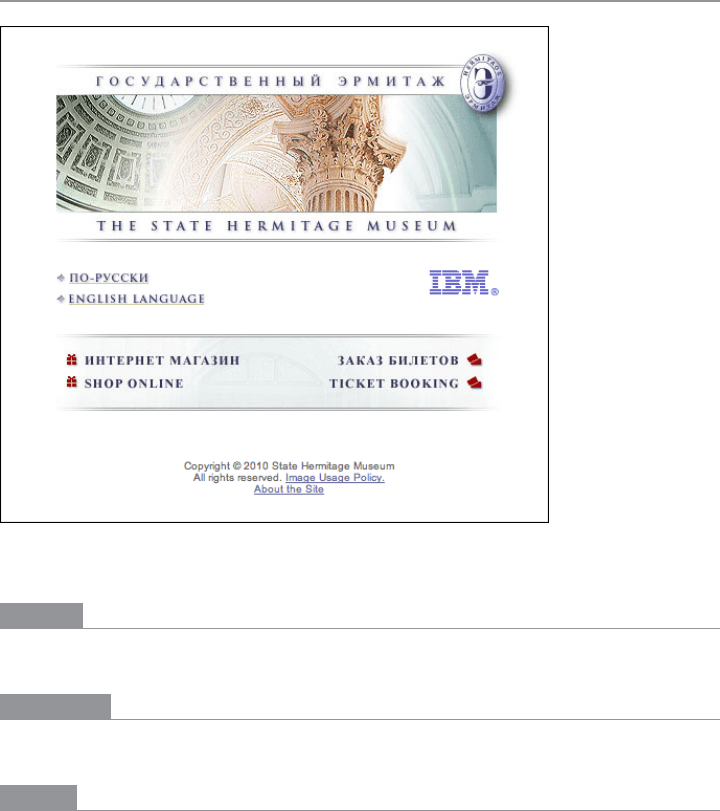
The Patterns 513
Hairlines
Figure 11-27.
Front page of HermitageMuseum.org
What
Use one-pixel-wide lines in borders, horizontal rules, and textures.
Use when
You want a refined and sophisticated look to your interface.
How
Here are some of the many ways you can use hairlines in an interface:
• To demarcate
Titled Sections by underlining the titles
• To separate different content areas, either with horizontal or vertical rules or with
closed borders
• As guidelines to lead the eye through a composition
• Between areas of different background colors to clarify the boundary between them

514 Chapter 11: Making It Look Good: Visual Style and Aesthetics
• In textures, such as a grid or a block of horizontal lines
• In icons, images, and drawn graphics
• As borders around controls, such as buttons
Hairlines look particularly good when placed near very thin sans-serif fonts. Remember
that a gray line looks thinner than a black line, even if both are a single pixel wide. The same
is true for other lighter colors, such as the teal used in Figure 11-27 at the top of this pattern.
The less contrast between the line and its background, the thinner and lighter it appears.
Another way you can lighten a hairline—and add another texture while you’re at it—is to
make it a dotted line instead of a solid line. As of this writing, finely drawn dotted lines are
becoming common on the Web, even as underlines for links.
A trick to increase the tension and edginess in a design is to push a hairline flush up
against the bottom of a line of text. Design 8 of the CSS Zen Garden designs does exactly
that with its title and headlines (see Figure 11-8, back in the introduction).
Examples
The website in Figure 11-28 shows hairlines used in many places: as a faint grid in the back-
ground, as horizontal rules, and as very lightweight borders around the boxes. The hairlines
work with the background texture and excellent typography to create a very rich look.
Figure 11-28.
Colly.com
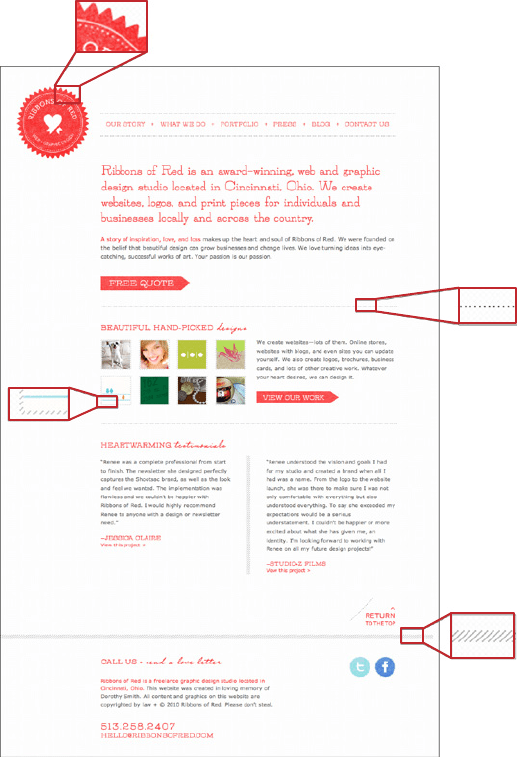
The Patterns 515
Likewise, hairlines are used in several ways in the design studio site shown in Figure 11-29.
Note their usage in the logo, in the dotted separator lines, and in the diagonal texture used
around the thumbnails and at the bottom of the page.
Figure 11-29.
RibbonsOfRed.com
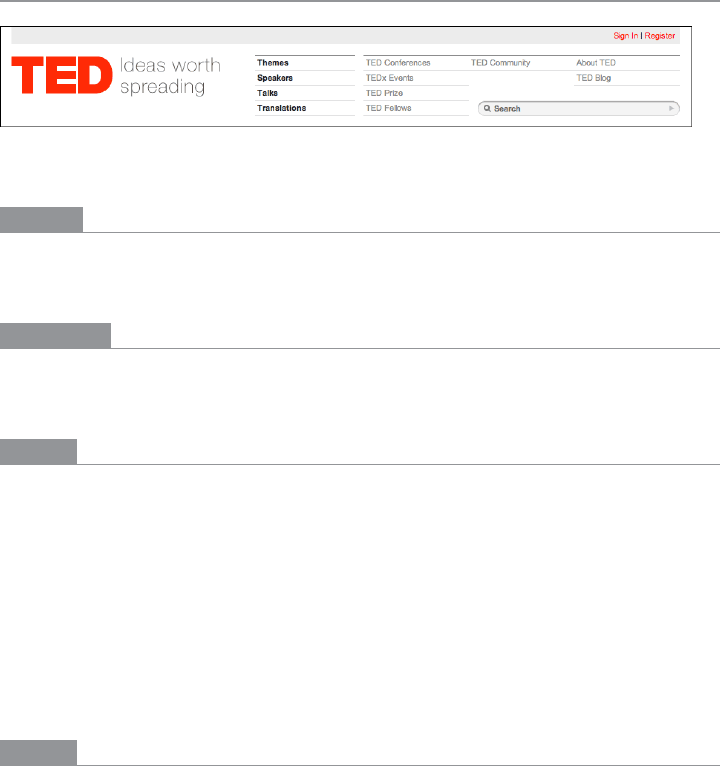
516 Chapter 11: Making It Look Good: Visual Style and Aesthetics
Contrasting Font Weights
Figure 11-30.
TED
What
Use at least two contrasting fonts—one thin and lightweight, another heavier and darker—
to separate different levels of information and add visual interest.
Use when
Text makes up important elements on the page, and you want the page’s organization to
be very clear at first glance. You want the page to look dramatic.
Why
When two fonts differ in weight, they form a strong and vibrant visual contrast.
Aesthetically, contrast contributes to a dramatic and eye-catching look. High typographic
contrast, which includes size, texture, and color—but especially weight—guarantees that
your page will not look dull.
You can use this contrast to structure the text on the page. For instance, heavier-looking
letters can form titles and headlines, thus helping build a visual hierarchy. The bold text
in Figure 11-30 pulls the eye toward it. Thus, contrasting font weights contribute to the
cognitive perception of the page as much as the aesthetics. (See Chapter 4 for a discussion
of visual hierarchy.)
How
This pattern has many possible applications. This book already mentioned the use of bold
text for headlines, but applications might include:
• Creating very strong, magazine-like headlines and subheads
• Separating labels from data in a two-column listing
• Separating navigational links from information
• Indicating selection, such as selected links or list items
• Emphasizing words in a phrase
• Separating one word from another in a logotype

The Patterns 517
If you’re using fonts that are larger than body text, make sure the contrast is strong enough
to be noticed. When the font family offers several weights, as does Helvetica Neue, pick
ones that are at least a couple of steps apart—if the contrast is weak, it looks accidental,
not intentional. (The same goes for other font attributes. If you make two text elements
different sizes, make them really different; if you want to mix font families, make sure they
don’t look too much alike!)
Examples
In Figure 11-31, a film site from the National Film Board of Canada uses three very differ-
ent font sizes in a harmonious and compact composition. Its drama and starkness reflect
the seriousness of the film’s subject.
Figure 11-31.
Detail of Waterlife.nfb.ca
The playful design in Figure 11-32 has a more complex visual hierarchy, rendered
with many font styles and sizes.
Contrasting Font Weights is used to emphasize the
“WORKFLOW” headline, the arrows, the column titles, and particular phrases within
the body text. The weighted phrases are not only a heavier font weight; they are also white,
while the surrounding body text is gray. This gives the phrases even more contrast against
the dark background, thus increasing their visual weight.
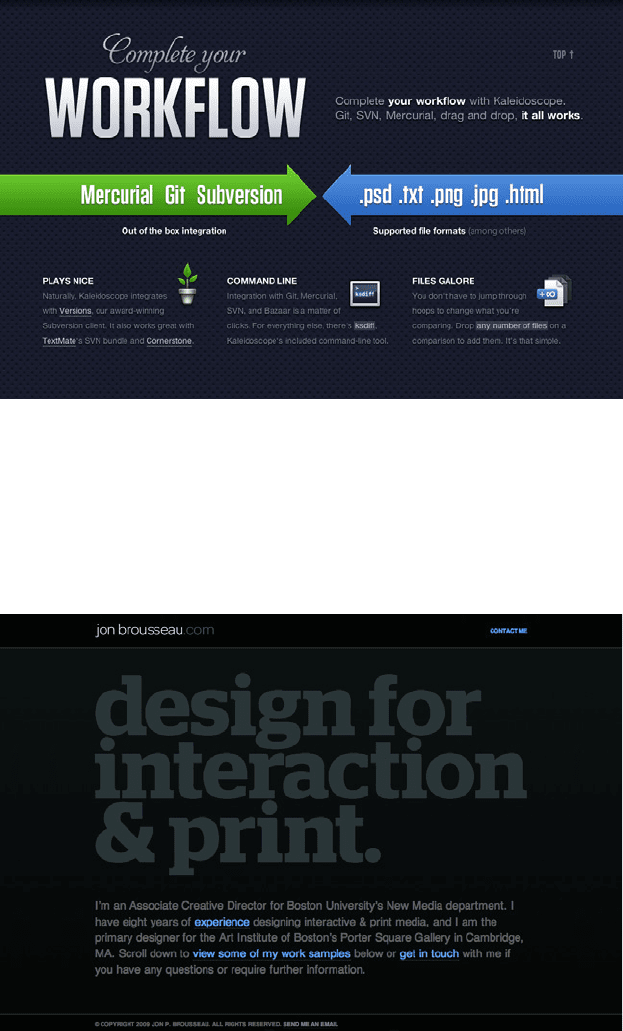
Figure 11-32.
A page from KaleidoscopeApp.com
Finally, Figure 11-33 shows one of the most dramatic type size differences I have ever seen
on the Web. Because they are dark, the enormous headline letters remain in balance (sort
of) with the body text. Within the block of body text,
Contrasting Font Weights is again used
for emphasized words and phrases; likewise for the URL in the upper left, which places a
heavier font next to a lighter one.
Figure 11-33.
JonBrousseau.com
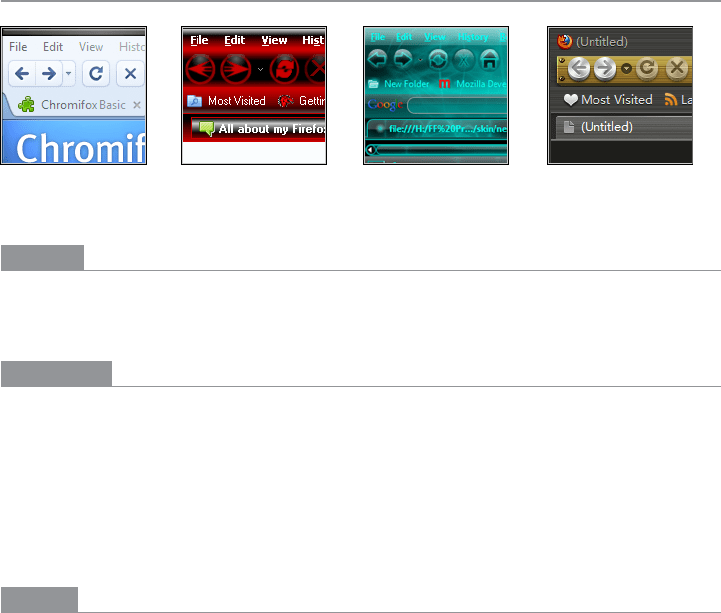
The Patterns 519
Skins and Themes
Figure 11-34.
Four sample Firefox themes
What
Open up the look-and-feel architecture of your application so that users and third parties
can design their own graphics and styles.
Use when
Your user base includes a large population of people who know your interface well.
For those people, the interface has relatively low cognitive requirements—it’s not used
in high-stress situations, for instance—so it’s not necessary to make all elements easily
recognizable.
Furthermore, these users like to tinker. They value style, and they are inclined to set soft-
ware preferences to suit their tastes.
Why
When people rearrange and customize their personal space, physical or virtual, they de-
rive a sense of ownership of that space. This is a basic human need (though not all people
act on it; many people are perfectly content with software’s “factory settings”). Changing
simple color and font preferences is one common way to customize someone’s software
environment, but
Skins and Themes go far beyond color schemes and fonts.
There’s evidence all over the Internet that users really like themes. Actually, we’re talking
about two groups of users here: those who download and use themes, and those who not
only use them but also design them. Those who design them see themes as an opportu-
nity to be creative, and to get their work out into the public eye. Many are graphic artists.
These people may get to know your UI design very, very well.
In any case, there are numerous applications and web services out there that have skins
or themes, and the sheer number of user-designed themes is enormous. The number of
person-hours spent on these works is testimony to the power of the creative impulse. For
the designers, skinnable applications fulfill another basic human need: creativity.

520 Chapter 11: Making It Look Good: Visual Style and Aesthetics
(The difference between a skin and a theme in this context is vague. Some applications
or sites use one, and some use the other. As of this writing, themes seems to be the term
of choice for the concept of user-designed interface styles, while the term skins appears to
apply more to physical skins on laptops or mobile devices. That wasn’t the case when the
first edition of this book was written.)
How
Exactly how to design and implement a skinnable application depends entirely on the UI
technologies you use, so it’s very hard to generalize anything here.
First, remember that any native Windows application can already be changed by a skin
or theme. Several popular browsers can be “themed” as well, as shown in Figure 11-34.
Second, themes for web services such as WordPress (see Figure 11-35) affect far more
than just the graphic styling shown on the blog pages. Their themes also determine how
blog posts are laid out, what content appears in the sidebars, and even what informa-
tion gets shown or hidden for each entry. Designing a UI architecture to support this is
hard, and beyond the scope of this book. I encourage you to look at existing examples of
themed applications and websites.
One objection that is sometimes raised about skins is that they make interfaces harder to
use. That’s true about many badly designed skins. Ask yourself, though: how much does
that matter? Does each application have to be cognitively perfect? (Look-and-feel defaults
aren’t perfect, though they’re certainly more usability-tested than skins are.) For an ap-
plication that someone already knows well and that doesn’t require high cognitive de-
mands, there’s a point at which its basic usability is “good enough” and personal aesthetic
preferences take over. When skins are available, people make that choice for themselves,
whether or not they’ve educated themselves about usability.
To an extent, you can—and should, as part of a designer’s responsibility—decide at which
level to permit theming and skinning. You may only allow colors, fonts, and backgrounds
to be changed. You may permit bitmap-level skinning that preserves layout while chang-
ing the look-and-feel of controls. Or you may allow full customizability; it’s up to you to
decide if that kind of freedom is likely to make the interface criminally hard to use.
I’m going to speculate that excellent application design—such as well-chosen functional-
ity, easily understood organizational models, appropriate navigation, good page layout,
and standard widgetry—can make an interface more resilient to bad themes. Design it as
well as you can, and then put it out there for people to customize at a level you decide is
appropriate. See what happens!
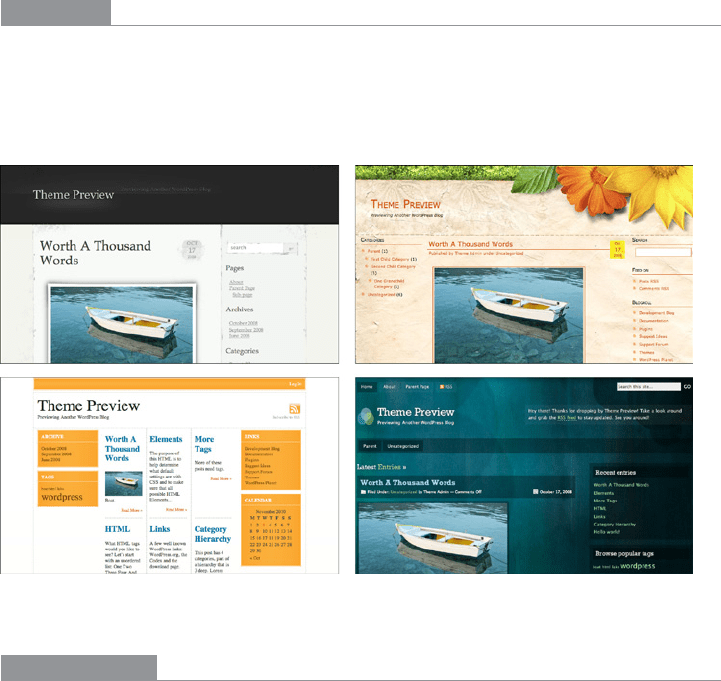
The Patterns 521
Examples
Figure 11-35 shows four of the many themes available for WordPress blogs. Vast numbers
of themes are also available for other blogs and website systems, such as Blogger and
Drupal. Most such themes are further customizable by the end users (especially those
who know how to edit HTML and CSS).
Figure 11-35.
Four WordPress themes
In other libraries
http://quince.infragistics.com/Patterns/Skins.aspx
